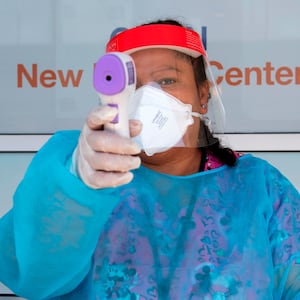The highly transmissible Delta coronavirus variant tore through an Oklahoma gym facility earlier this year, infecting dozens of teenagers, landing one unvaccinated person in the ICU and providing a stark reminder that the fight against COVID-19 is far from over.
Low COVID vaccination rates, the highly transmissible variant, and disturbingly lax social distancing rules in the facility combined to fuel the outbreak, according to a CDC report.
The report not only underscores the continued risk to children—who are only approved for the vaccine if they’re over 12—but also the consequences of pandemic fatigue and sluggish vaccination rates in Oklahoma, where less than 40 percent of the population has been vaccinated. At the time of the gym outbreak, it was less than 25 percent.
“It’s almost like it’s going to be two Americas,” Anthony Fauci, head of the U.S. National Institute of Allergy and Infectious Diseases, recently told CNN.
“When you have such a low level of vaccination superimposed upon a variant that has a high degree of efficiency of spread, what you are going to see among undervaccinated regions, be that states, cities or counties, you’re going to see these individual types of blips.”
The Oklahoma outbreak most likely began at the start of April, when one or more gymnasts or staff members had an undetected case of COVID.
By mid-May, lab workers notified Oklahoma state health officials that they had detected 21 Delta specimens clustered in central Oklahoma.
Public health surveillance data indicated that the cases were associated with the local gymnastics facility, according to the CDC report, which doesn’t name the facility.
A thorough investigation kicked into gear, with health officials interviewing the 21 people and conducting contact tracing. They obtained a roster of gymnasts and staff members, and a schedule of training sessions and gymnastics meets, which revealed that four gymnasts had traveled to two meets in other states while they were infectious. Investigators scoured the web for results from those meets to identify other possible contacts.
By late May, they had traced 47 COVID-19 cases to the outbreak—23 gymnasts, three staff members, and 21 of their household contacts.
The median age for infected people was 14, and the outbreak affected people aged 5 to 58.
Thankfully, investigators didn’t find any secondary spread among Oklahoma gymnasts participating at the out-of-state meets.
But, disturbingly, just four of those 47 people were fully vaccinated and two adults, both unvaccinated, ended up in the hospital.
While teenagers weren’t eligible to get the vaccine at the time of the outbreak, there were 13 people who came down with the virus who were eligible.
And of the 194 people identified as being exposed to the outbreak, 74 were eligible to get the vaccine but the vast majority of them had not.
The report also highlighted several questionable practices at the gym that could have accelerated the outbreak, like non-adherence to quarantine and testing guidance, no mask use among gymnasts, and people brushing off possible cases because they only had mild symptoms.
The facility had a policy of making people wear masks if they weren’t active participants but “this policy was not always observed,” the report says.
The facility also had poor ventilation, staff members cycling through different groups of people, low COVID-19 vaccination rates that were only “partly related to age eligibility,” inadequate cleaning of high-touch surfaces, and mixing between class groups.
The outbreak foreshadowed the aggressive spread of the Delta variant, which now makes up more than half of all COVID cases in the U.S. and is sending cases soaring again in 24 states.
“It is entirely foreseeable that the U.S. will experience surges, particularly in states with relatively low vaccination coverage,” Lawrence Gostin, a Georgetown University global health expert, told The Daily Beast earlier this week.








